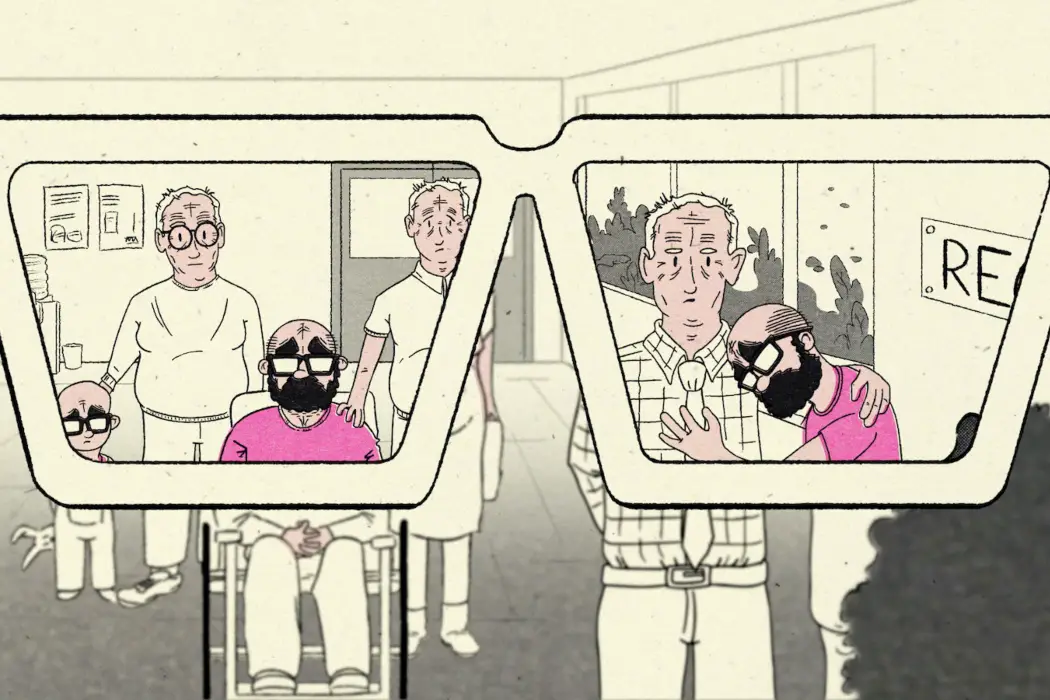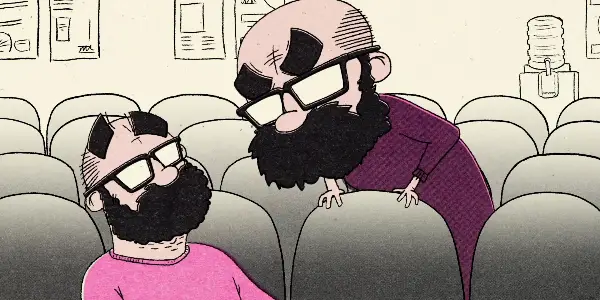LONG LIVE MY HAPPY HEAD: Scottish Brain Cancer Comic Doc Will Wreck You

Film critic, Ithaca College and University of St Andrews graduate,…
I have a pin on my desk of a bald man being punched in the face. That’s Gordon Shaw. He’s the artist-hero of Long Live My Happy Head, a new Scottish documentary directed by Austen McCowan and Will Hewitt. The film depicts Gordon’s art, life, relationships, and battle with cancer. It’s streaming in the UK now, but I managed to catch it what feels like forever ago at the Sands: International Film Festival in St Andrews, Scotland, where the film reduced me to a blubbering pile of tears and a buoyant skeleton.
Many might not want to talk about their tumors or their health problems as candidly or as frankly as Gordon does in the film. He’s not just come to terms with it, that it’ll one day be his undoing, but he’s named it Rick and draws it like a floating pink skull with a potty mouth. Cartoon Gordon, on the other hand, has a big bushy beard — even bigger and bushier than it is in real life — as well as blocky comic eyebrows and opaque glasses that conceal his eyes. All the better to not be seen with, he says in the doc.
Gordon’s The Nicest Guy Ever
The documentary’s most transcendent moment sees Gordon — or, rather, the cartoon version of him — enter an MRI machine and, to the machine’s Dubstep-like mechanical whirrs, he floats out of the device, pumping his arms like he’s got disco fever, and drifts through space. It’s both completely insane and incredibly sensitive, the beat is catchy, and if you showed the scene to a Victorian child or something, they’d probably die of shock. It’s amazing.
Long Live My Happy Head often slips into this animated style; animated documentaries are having a moment, among this, Oscar nominee Flee, and fellow Scottish doc My Old School. In Happy Head, the animations look like one of Gordon’s comic books come to life. Since his diagnosis in 2012, he wrote and illustrated Bittersweet, a darkly comic autobiography about his battle against his brain tumor, personified in the aforementioned Rick, that gnarly little memento mori–type bugger. Happy Head is part-adaptation of Bittersweet, since many of that book’s cotton candy pink–saturated pages seem to leap to the screen as Gordon and Rick argue.
The film uses this device to create distance between us and all the shit Gordon has to deal with, keeping the most traumatic parts of the story behind a cartoon veil. This also has the effect of making Gordon’s battle against cancer more appealing to audiences who might not be terribly keen on such a dark story. But moreover, Happy Head illustrates Gordon’s artistic process and mind, celebrating his humor and his work and allowing him the reins of his own story, to tell it in the only way he knows how to: through art.

Happy Head finds Gordon at work on a second comic project, this one profiling carers, and an art installation that turns the drones, buzzes, and whirrs of an MRI into music and allows guests to enter a makeshift MRI machine themselves. We see Gordon tinkering and drawing, mostly from his apartment in Leith (a district of Edinburgh, of “Sunshine on” fame). Come the COVID-19 lockdown, he’s all the more holed up inside, and we feel that frustration and isolation coming down like a planet on Gordon’s shoulders. There’s a bunch of shots of squirrels outside his flat and on the streets of Edinburgh — probably an accident, but a good zoomorphism for the industry, efficiency, and cheeky fun with which Gordon works, particularly when the pandemic’s forcibly squirreled him away in his flat.
A Probably Boring Note On Documentary Ethics
Look — I say, pounding my gavel — Long Live My Happy Head is a great documentary that showcases great documentary practices. After decades of shock docs, mostly led by the true-crime type, exploiting people’s suffering or grisly death for the sake of generating tension and trying to wring empathy out of misery, Long Live My Happy Head handles its tricky subject matter of Gordon’s cancer diagnosis and privacy with the utmost sensitivity. And frankly, it’s just really nice to see.
When he’s quarantined inside, the filmmakers send him a camera so he can be the director of his story, if only for a few months, giving us plenty of goofy DIY scenes of Gordon doing laps around his flat for exercise, or first-person footage of Gordon going on a walk outside, remaining wary of doorknobs and crowded spaces (as cancer treatment makes one’s immune system weaker and more at risk of severe infection from COVID).
The willingness of the filmmakers to go with the flow, meet obstacles so naturally and carefully, and prioritize Gordon’s safety and security over all else is inspiring. This is how documentary filmmaking needs to be taught in film schools!
This focus on Gordon’s well-being softens the doc, in a way — not like a marshmallow softens in a flame, nor like a porcupine’s belly might be soft against attacks, but it allows Long Live My Happy Head to become a sort of Trojan Horse of emotion. Let its marshmallow softness roll over you, and then it snaps its jaws shut, I mix my metaphors, and then surprise, there are Greek soldiers in your marshmallow and you haven’t been able to stop crying for the last 40 minutes. (I’m also dizzy with COVID right now and have really no idea what I’m talking about.)
Gordon + Shawn xoxo
The doc also focuses on Gordon’s partner, Shawn Puller — who also went to Ithaca College, as I learned at the post-festival cool kids’ table, go Ithaca — and who works at the Garth Newel Music Center in Virginia. Shawn and Gordon attend a Pride parade early in the film, and it’s fun to see these two quiet grizzly bear–kinda guys letting loose in the crowd. It’s also one of the only trips Gordon can make stateside, as brain tumors, treatments and medications tend to adversely affect one’s ability to travel.

The filmmakers say that Long Live My Happy Head is, at its core, a love story. One brief scene of the pair sitting at Arthur’s Seat in Edinburgh, overlooking the city, is one of the most moving in the film. Their companionship and steadfastness make even the most mundane scenes they share shine. It’s on the hill (as well as in the MRI disco scene) that composer Alexandra Hamilton-Ayres’ miraculous, layered score is able to rise and elevate the drama with it.
I saw Long Live My Happy Head twice — as a student curator for the Sands festival, I watched it once when the curating team agreed unanimously to play it, and I saw it again on the closing night, when Gordon and Shawn, as well as McCowan, were in the audience and spoke after the film. Gordon and Shawn, incidentally, had been at nearly every screening at Sands and the keynote talk by Joe Russo. Nobody was at all the events, and to do all that for a festival where they’re the closing-night guests is nuts. Gordon and Shawn also always joined the other filmmakers, subjects, organizers, and volunteers at the pub every night after that day’s screenings, and they’re some of the most down-to-earth, friendly people I’ve ever met. Or maybe I’m just saying that because they gave me a pin of Gordon being punched in the face…
Conclusion
As a biography of Gordon and a portrait of his artistic process and the struggles he fights uphill against, Long Live My Happy Head is as warm, comforting and familiar as that apple pie recipe Shawn has to call home to get. (I’m pretty sure he calls his mom; it’s been a while since I’ve seen the film. Come to think of it, it may not even have been a pie at all, but look — it’s better for the metaphor if it was.) The film is comforting apple pie cinema in a Rooney Mara A Ghost Story kind of way, like it’s something you need to consume sitting in the dark on your kitchen floor, wolfing it down bite after monstrous bite, bawling into it as you do, because the flavor of the pie is not the same as the flavor of the pie tinged with your tears, and then maybe you’ll get up and run to the bathroom to vomit when you’ve had enough.
Long Live My Happy Head — therein are the signs of a vibrant life lived to the fullest despite all the mountains of bullshit and wallops of stress, depression, anxiety, and memory stuttering: homemade apple pie recipes, patting a big dog, dancing like you’re not being filmed, laps around the flat sarcastically undertaken in the name of exercise. And the larger, more obviously celebratory scenes hold the same weight: Shawn surprising Gordon on his birthday with a Zoom party; a launch party for Gordon’s MRI installation; the pair marching, singing, and dancing at a Pride parade.
My father got a cancer diagnosis a few years ago, and my friend’s mom is in treatment for hers right now. Long Live My Happy Head allowed us both to sit there, crying our eyes out, witnessing the kind of conversations and cathartic cry seshes that I, at least, had been trying to avoid on behalf of my own father. It’s like group therapy or that bit in Midsommar where all the cultists scream with Florence Pugh. In the dark, I held my knees against my chest, curled up in my seat like an armadillo, and stared ahead at the screen, trying to avoid eye contact with anybody, tears waterfalling down my face. A film hasn’t done that to me… like… ever.
McCowan and Hewitt’s film is so carefully emotionally intertwined with Gordon’s own story — and so much an extension of Gordon’s cheeky, giddy art and wonderful sense of humor — that it’s rather uncomfortable to review, honestly. Suffice to say that the film is great, worth a watch, and it’ll destroy you emotionally.
Have you seen Long Live My Happy Head? Comment below and let us know your thoughts!
Long Live My Happy Head is available on BBC iPlayer in the UK and premieres in North America at Frameline Fest on June 19.
Watch Long Live My Happy Head
Does content like this matter to you?
Become a Member and support film journalism. Unlock access to all of Film Inquiry`s great articles. Join a community of like-minded readers who are passionate about cinema - get access to our private members Network, give back to independent filmmakers, and more.
Film critic, Ithaca College and University of St Andrews graduate, head of the "Paddington 2" fan club.













